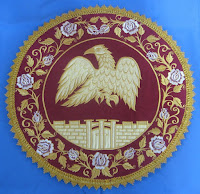Not that anyone left the windows open last Sunday, but there are more birds in the sanctuary than one would otherwise expect. Whether depicted in stained-glass, carved in stone, or jutting from a pulpit, birds have for centuries been carriers of symbolism within Christendom. Knowing the difference between species and the sometimes-subtle variations can help in one’s visual understanding of the buildings where worshipers flock.
 |
| Eagle lectern. (St. Mary Redcliffe, Bristol, England) |
The Holy Spirit is most often identified by the image of a dove, but that image sports a couple of important features – or at least it should. The Dove is always shown descending, with its head down. This is to indicate that inspiration comes via the Helper, who is from above. The head is also usually given a tri-radiant halo [that is not a cross] to indicate that it is a Person of the Holy Trinity. There are the odd occasions in sacred art in which the Dove might be seen near the ear of a figure – either near a prophet, indicating Divine inspiration in their writings, or near Mary, the Mother of our Lord, in which case the conception of our Lord is being shown.
When a dove is used to indicate peace, it should always be shown flying horizontally, sans nimbus. Also, it typically carries an olive branch in a reference to the aftermath of the flood. Because this bird often flies off-course into crowds of tie-dyed shirts and love beads, it’s probably wise to avoid this version entirely out of confusion.
One of the earliest winged symbols used in the Church is a bit of a stretch where ornithology is concerned. The Phoenix was borrowed from Greek mythology, but it wasn’t the normal brand of bird. When occasionally used by the Church, it is an identifier of Christ Jesus. According to myth, the bird died by fire, then later arose again from the ashes. It’s questionable origin nonetheless was used by some early Christians to point to the death and resurrection of Jesus.
 |
| Orlets rug. (Courtesy, pokrovchurchsupply.com) |
Another ornithological symbol with dubious origins is “The Pelican in Her Piety.” The simple fact that the image carries such a title gives a good hint to its Medieval age. The pelican is shown piercing her own breast so that her young may live. The idea that pelicans would sacrifice themselves in such manner made it an endearing symbol of our Lord. Unfortunately, like some other metaphorical images used in Christian symbolism, the self-sacrifice of a pelican is totally unfounded in the natural world.
Eagles play an important role in Church symbolism, but one must take context into account before assigning meaning. Anglican churches, among some other denominations, sometimes have pulpits or lecterns that sport eagles of size enough to accommodate a large bible on the backs of spread wings. They exude a decided “federal” feel, as if talons should clasp bolts of lightning or laurel wreath. In this context, however, the eagles pay homage to the Word of God, for in former days eagles were thought to fly unflinchingly toward the sun. The noble birds were incapable of being blinded – even by the brilliance of the Word itself.
 |
| Rooster vane. (Trinity Church, Veilsdorf, Germany) |
In somewhat similar manner, the Orthodox Church sometimes uses the image of a young eagle on a small rug – or “Orlets” – on which a bishop stands while officiating. The eagle flies over the image of a city, indicating the populace over which the bishop presides.
Of course, the eagle is also the symbol of the Evangelist St. John. In this context, its meaning originates from the soaring style of the Gospel writer’s words.
Strangely enough, the barnyard’s entry has somehow taken preeminence on the occasional church building. It is common enough to note when a rooster supersedes all other symbolism – even the cross – on pinnacles of some church spires. It may seem a bit odd, until one unravels its meaning. The rooster became an uncomfortably-humbling reminder to Peter that he had denied Jesus three times. But while the rooster reminds us of the Law and our utter failure in its keeping, it also reminds us of the Gospel, for roosters announce the early morning, and where congregations worship on the eighth day, the rooster reminds us weekly that He is risen indeed.
No comments:
Post a Comment